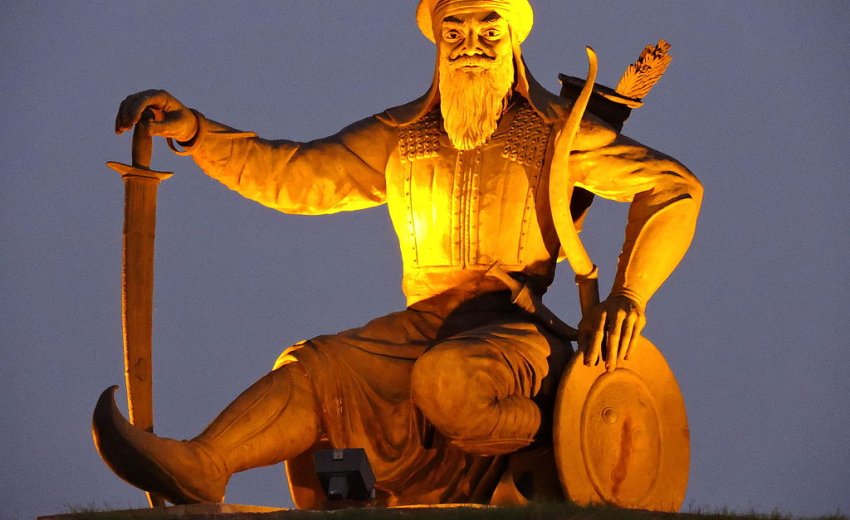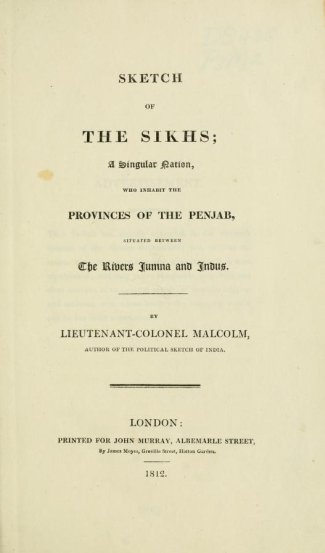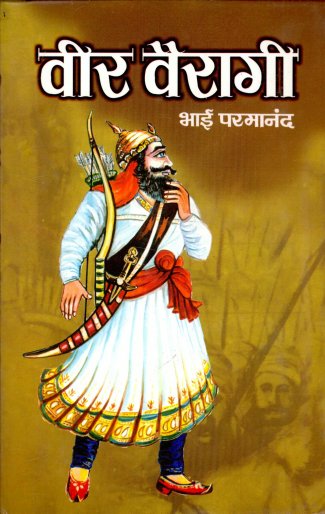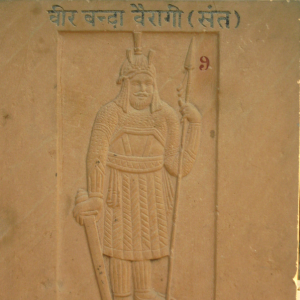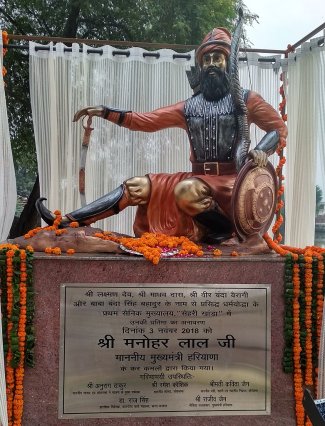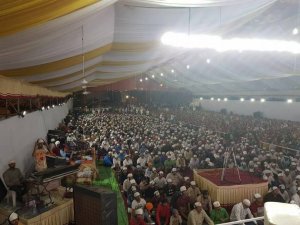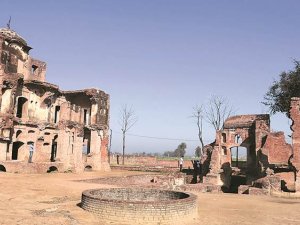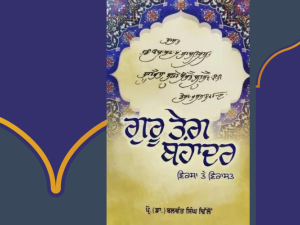INTRODUCTION
Banda Singh Bahadar is an enigmatic and intriguing character in the early 18th-century history of Northern India. During his short stint from 1709-16, he shook the foundation of the Mughal Empire in India. Very little is known about the early life of Banda Singh and speculations by early writers have been presented as history and irrefutable truth. This short article will critically explore the ethnic background of Banda Singh and how in the 20th century it got embodied with contrasting philosophies.
EARLY SIKH WRITINGS
John Malcolm (1812) sums up the status of the Banda Singh amongst Sikhs during the earlier nineteenth century. He writes that ‘they do not revere his memory, and he is termed by some of their authors, a heretic who, intoxicated with victory, endeavoured to change the religious institutions and laws of Guru Gobind Singh’ (1). The accusations made by traditional Sikh scribers against Banda Singh were that he married despite being told against it. He introduced the greeting ‘Fateh Darshan’ to replace the Khalsa salutation of ‘Wahe Guru Ji Ka Khalsa! Wahe Guru Ji Ki Fateh’. Further Banda Singh was accused of promoting a vegetarian diet.
Ratan Singh Bhangu (1841) author of Sri Guru Panth Prakash (commonly known as Parchin Panth Prakash) who devoted several chapters of the Banda does not refer to him as Singh or Khalsa even once in writings! (2)
Giani Gian Singh (1822-1921) was the first Sikh who wrote the whole Sikh history and unlike earlier Sikh writers who wrote in poetry, he wrote in prose and modern-day Punjabi. His Tawarikh Guru Khalsa (post Guru period books were later named Shamsher Khalsa and Raj Khalsa) written in several volumes in Urdu and Punjabi from 1890 onwards became very famous, also repeated the above allegations against Banda Singh without questioning or probing the accusations.
Karam Singh Historian (1884-1930) was perhaps one of the earliest Sikhs who studied and analysed history critically. He and later Prof. Ganda Singh (1900-87) argued against these accusations logically. Sikhs are not forbidden to marry hence it is not possible that Banda Singh received any such commandment for Guru Gobind Singh. Banda may have styled himself as a King, but the coins he issued, considered signs of sovereignty, were in the name of Guru Nanak and Guru Gobind Singh. Misls Sardars and Maharaja Ranjit Singh followed this practice. Banda introduced a new salutation ‘Fateh Darshan’ not to replace ‘Wahe Guru Ji Ka Khalsa Wahe Guru Ji Ki Fateh’ but the new salutation was an additional one. However, it was rejected by the Khalsa. (3)
BHAI PARMANAND ON BANDA
Karam Singh Historian (1907) authored a Punjabi book, Banda Bahadar which was published by Chief Khalsa Diwan, Amritsar. This was an honest attempt to write a biography on Banda Singh Bahadar however the author commented in the book that he had been unable to find a reference that suggested Banda was administered Khande de Pahul. (4)This erroneous comment was picked by a prominent leader of Hindu Mahasabha and a member of the Ghadr Party, Bhai Parmanand.
Bhai Paramanad was considered as one of the descendants of the Bhai Mati Das and Bhai Sati Das who accompanied Guru Tegh Bahadar to Delhi in 1675 and were also martyred by the Mughals. Their grandfather, father, and other descendants severed the Sikh Gurus with distinction. They were given the title of ‘Bhai’ which means brother as a mark of respect and recognition of their contribution.
Bhai Parmanand also belonged to the Chhibber clan of village Kariala in district Jhelum (now in district Chakwal). It is not uncommon, but every clan member claimed the lineage of the martyred family. The Singh Sabha movement at the time was staunchly promoting the separate Sikh identity. Bhai Parmanand followed the opposite philosophy that believed that Sikhs are Hindus.
Bhai Parmanand (1921) wrote a book in Hindi titled Veer Vairagi. In the foreword, the writer tried to prove Banda was a Hindu ascetic who laid the foundation of Hindu rule in Punjab. He credited Banda for completing the ‘unfinished work’ of Guru Gobind Singh. (5) He wants to remind Sikhs that his ancestor Bhai Dharam Singh was appointed Diwan by Guru Gobind Singh. In a way, he acknowledges that his ancestors became Khalsa. Kesar Singh Chhibber (1769) writes that his father Gurbaksh Singh (son of Dharam Singh) was the daroghah or manager of Mata Sundri Ji, wife of Guru Gobind Singh Ji. (6)
Bhai Parmanand asserts that Sikhs are Hindus which seems strange because his book emphasises that it was Banda Vairagi, a Hindu ascetic who revolted against the tyrannical rule of Mughal. As the writer felt that Sikhs were Hindus then admitting that Banda took Khande de Pahul like some of his ancestors should not have been an issue. However, he was adamant that Band remained a staunch Vairagi (ascetic) Hindu throughout his life and considered him the hero of Hindus. (7)
Karam Singh Historian (1928) as a rebuttal to Bhai Parmanand’s book written in Urdu, Banda Kaun Tha. This was translated into Punjabi and published in 1934. In these works, he used Persian and Punjabi sources to prove Banda and his soldiers were Sikhs. (8) The next year, Prof. Ganda Singh wrote his monumental work, Life of Banda Singh Bahadur which even after 90 years (almost) inspires readers and authors alike. However, despite this outstanding work, there were still some skeptical historians.
DID BANDA BECOME A KHALSA?
Prof. Hari Ram Gupta (1902 -92) celebrated historian who wrote 5 volumes on the History of Sikhs has written that Guru Gobind Singh made Banda his disciple but did not give Khande de Pahul hence he was not a Khalsa. (9)
This is in sharp contrast to Prof. Ganda Singh who has provided names of 35 historians from Hindu, Sikh, Muslim, and Christian religions who wrote that Banda was a Sikh. Surprisingly and disappointingly Prof. Gupta gives only one name to back his claim. He states that Giani Gian Singh of Guru Panth Prakash (first edition 1880) wrote that Banda was not made a Khalsa. The Guru Panth Prakash clearly states that Banda was made a disciple and Sikh by Guru Gobind Singh Ji.
Shahr Nanded Godavari Tat, Othare Joi Jay. Bande Ko Nij Sikh Kar, Pathae Punjab Desaye. |2|(10)
In Tawarikh Guru Khalsa, Giani Gian Singh writes that Madho Das became Guru Ka Sikh and was named Banda Singh. (11)
Prof. Gupta makes a rare mistake. Bhai Parmanand’s ancestor wrote that Banda took Khande de Pahul and became Khalsa. Kesar Singh Chhibber (1769) in Bansavalinama Dasan Patshahian Ka writesPahul Guru Ki Chhak Ke, Banya Singh Hathhiya |623|(12)
WHAT WAS BANDA SINGH’S CLAN OR TRIBE?
Banda was born Madho/Lachman Das in a humble background, and little is known about his childhood or youth. Giani Gian Singh in Shamsher Khalsa Part 1 was the first historian who remarked about the clan of Banda Singh. He states that Banda was a Rajput according to an old book/manuscript (pothi). The name of Banda’s father is given as Ram Dev Kshatri is stated as an owner (maalik) of 2-3 villages. The Giani does not provide any details of this old manuscript hence no one has seen it.(13) Bhai Parmanand and Prof. Gupta also noted Banda as Rajput citing Giani Gian Singh.
Karam Singh Historian (1905) wrote a book on Banda Singh titled Banda Bahadar where he states that Banda’s father was Ram Dev who was a Bhardwaj Rajput and as he was not a government official, he did not have much money! The financial status of Ram Dev was that of the middle class (vichle mail). In terms of profession, Karam Singh is slightly vague and simply writes that he same line of work as his fellow community members.(14) The historian does not provide any reference to the Bhardwaj clan.
Prof. Ganda Singh (1935) writes that Ram Dev was an ordinary ploughman Rajput of the Bhardwaj clan and Banda was born in poor circumstances. Interestingly from the owner of 2-3 villages, Ram Dev was now depicted as a poor farmer.(15) The esteemed historian provides Giani Gian Singh and Karam Singh Historian as references regarding this assertion.
BANDA AS A KHATRI
Farsi chronicler Khafi Khan (1731) in Muntakhabu ‘l Lubab writes ‘From amongst the Khatris, (some) who regarded themselves in secret as the followers and disciples of that rebel,” approached Muhammad Amin Khan and other intermediaries of nobles with offers of large sums of money in return for that wicked man’s life being spared, but this was not listened to.’(16) It is interesting to note that Khatris are stated as secret followers of Banda, and they offered a pay-off to the Mughals if Banda’s life could be spared.
Budh Singh Arora (1783) in Risala -i-Nanak Shah written in Farsi states that Banda was prior friends and had immense faith in Guru Gobind Singh. (17)Based on these historical records, some people have suggested that Banda was from a Khatri background. Although these are much older accounts, the evidence is conjectural.
During the years from 1884 to 1900, R.C. Temple authored three volumes of The Legends of the Panjab. The Vol 3 in the preface refers to, LXIX The Story of Banda Bairagi, amongst others which have been prepared for publication but not yet published.(18)
HA Rose complied A Glossary of the Tribes and Castes of the Punjab and North West Frontier Provincein three volumes based on the Census Report for the Punjab, 1883, by Denzil Ibbetson and the Census Report for the Punjab, 1892, by Edward Maclagan. These three volumes were published between 1911 and 1919. The ballad Ahwal I Lachhman Das urf Banda Sahib Chela Guru Singh Sahib by Hakim Rai which was perhaps noted and prepared by R. C. Temple was now published by H.A. Rose. In the first line of the ballad, Hakim Rai says that Banda belonged to the Sodhi Khatri lineage.(19) Earlier in the footnote, Rose mentions that according to another account, Banda was a Punjabi Khatri of Sialkot district. (20)
Sahib Kaur, the second wife of Banda Singh Bahadar and his son Ranjit Singh survived him.(21) The Gurdwara Dera Baba Banda Singh Bahadar at Reasi, 75 km from Jammu is headed by Baba Jatinder Pal Singh Sodhi a descendant of Banda Singh Bahadar. Mahant/Baba Fateh Singh was a contemporary of Maharaja Ranjit Singh who bestowed 4 jagirs to him.(22)
The records at the above Dera state that Banda Singh Bahadar was the spiritual (Naadi) son of Guru Gobind Singh. The name of the biological father of Banda is not mentioned in the genealogical table(kursinama). This is also stated in the old Pande Vahis in Hardwar.(23)
CLAIM OF BANDA AS MOHYAL BRAHMIN
P.N. Bali (1986) in The History of the Mohyals claimed that Banda was a Chhibber Brahmin without any reference. (24) This contention seems odd as Banda was not mentioned in T.P. Russell Stracey’s (1911) authored book, The History of the Muhiyals, the Militant Brahman Race of India which was compiled for the General Muhiyal Sabha.(25) Lahore. A reprint edition was published in Lahore in 1938. Again, there is no reference to Banda in this edition.
CONCLUSION
Banda took Khande de Pahul and became Khalsa and came to be known as Banda Singh Bahadar. It seems strange when some people and institutions prefer him to call him Bairagi as ascetic are wonderers and remain single throughout their life. After becoming Khalsa, Banda married twice and had children.
There is no denying that Banda was a Hindu ascetic before he became a Khalsa. There is something called shared history and heritage. Bhai Parmanand and Prof. Hari Ram Gupta are wrong when they assert that Banda remained Hindu throughout his life and never took Khande de Pahul. Bhai Parmanand’s ancestor Kesar Singh Chhibber (1769) wrote that Banda took Khande de Pahul and became Khalsa.
Let’s examine an existing case. In 1989, a young man of 23 years of age and a budding musician by the name of Dileep Kumar who belonged to the Hindu religion embraced Islam and changed his name to Allah Rakha Rahman. The young man then achieves success and fame as a film music scorer across India and rest of the world. Would we call A.R. Rahman by his old name Dileep Kumar, 100 years from now?
References
(Endnotes)
1. John Malcolm (1812) The Sketch of the Sikhs. London: John Murray p 83
2. Balwant Singh Dhillon (2004) Sri Gur Panth Prakash Kirt S. Rattan Singh Bhangu (Punjabi). Amritsar: Singh Brothers. 3. Ganda Singh (1935) Life of Banda Singh Bahadur. Amritsar: Khalsa College.p 85
4. Karam Singh Historian (1934) Banda Bahadar aate Banda Bahadar Kaun Si (in Punjabi). Reprint 1998. Amritsar: Dharam Parchar Committee p 1
5. Bhai Parmanand (1921) Veer Vairagi (in Hindi). Reprint 2001. New Delhi: Prabhat Prakashan p 9-10
6. Gurbakhsh Singh entry in The Encyclopaedia of Sikhism published by Punjabi University, Patiala
7. Bhai Parmanand (1921) op. cit. p 112
8. Karam Singh Historian (1934) op.cit. p 139
9. Hari Ram Gupta (1978) History of the Sikhs Vol. 2. New Delhi: Munshiram Manoharlal. p 4-6
10. Sri Guru Panth Parkash Purabaradh Kirt Giani Gian Singh (Punjabi). p1446 accessed on 14th Sept. 2024 from https:// rarasahib.com/online-library/
11. Tawarikh Guru Khalsa (Ithas Sri Guru Gobind Singh Ji) Kirt Giani Gian Singh (Punjabi).p352 accessed on 14th Sept. 2024 from https://rarasahib.com/online-library/
12. Piara Singh Padam (1997) Bansavalinama Dasan Patshahian Ka (Punjabi). 2nd ed. Amritsar: Singh Brothers.p183 Raijasbir Singh (2001) Bansavalinama Dasan Patshahian Ka (Punjabi). Amritsar: Guru Nanak Dev University.p117
13. Tawarikh Guru Khalsa Hissa Duja Arthat Shamsher Khalsa. Reprint 1970. Patiala: Bhasha Vibhag. p 1
14. Karam Singh Historian (1934) op.cit p 1
15. Ganda Singh (1935) op.cit., p 1-2
16. J.S.Grewal & Irfan Habib (2001) Sikh History from Persian Sources. New Delhi: Tulika.p 158
17. Balwant Singh Dhillon (2011) Banda Singh Bahadur Farsi Sarot. Amritsar: Singh Brothers. p 243
18. R.C. Temple (1900) The Legends of Panjab Vol 3. Bombay: Education Society Press. p vi,473
19. H.A. Rose (1919) A Glossary of the Tribes and Castes of the Punjab and North West Frontier Province Vol 1. Lahore: Government Printing Punjab. p 722,726
20. Ibid.p 698
21. Banda Singh (1935) op.cit. p 268
22. Ibid. p 270
23. Mohan Singh Bangoo (2020) Singh Soorma Banda Singh Bahadar (Punjabi). Mohali: Lokgeet Prakshan.p17
24. P.N. Bali (1986) The History of the Mohyals. New Delhi: General Mohyal Sabha
25. Russell Stracey (1911) The History of the Muhiyals, the Militant Brahman Race of India. Lahore: General Muhiyal Sabha
This article was originally published in the Abstract of the Sikh Studies Journal Oct-Dec 2024 Issue
